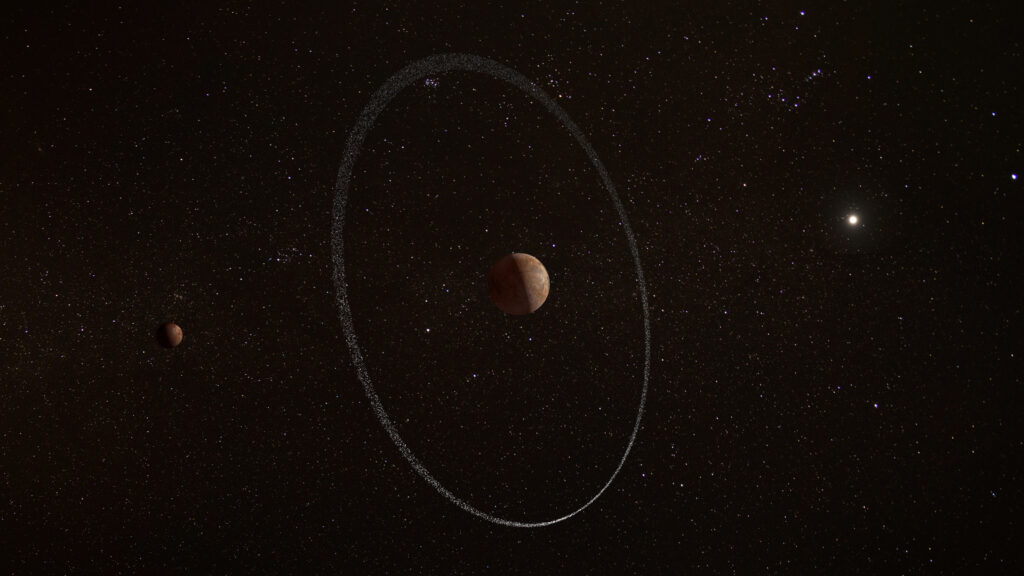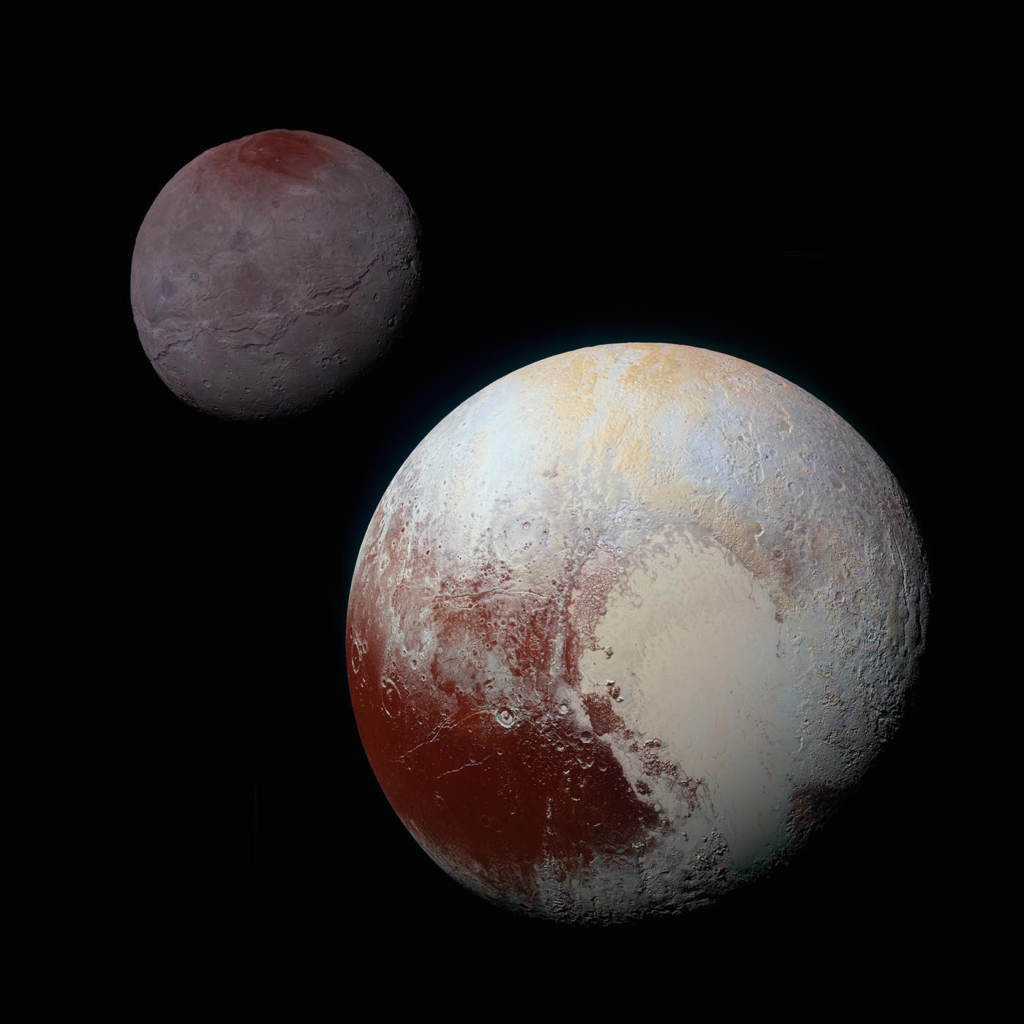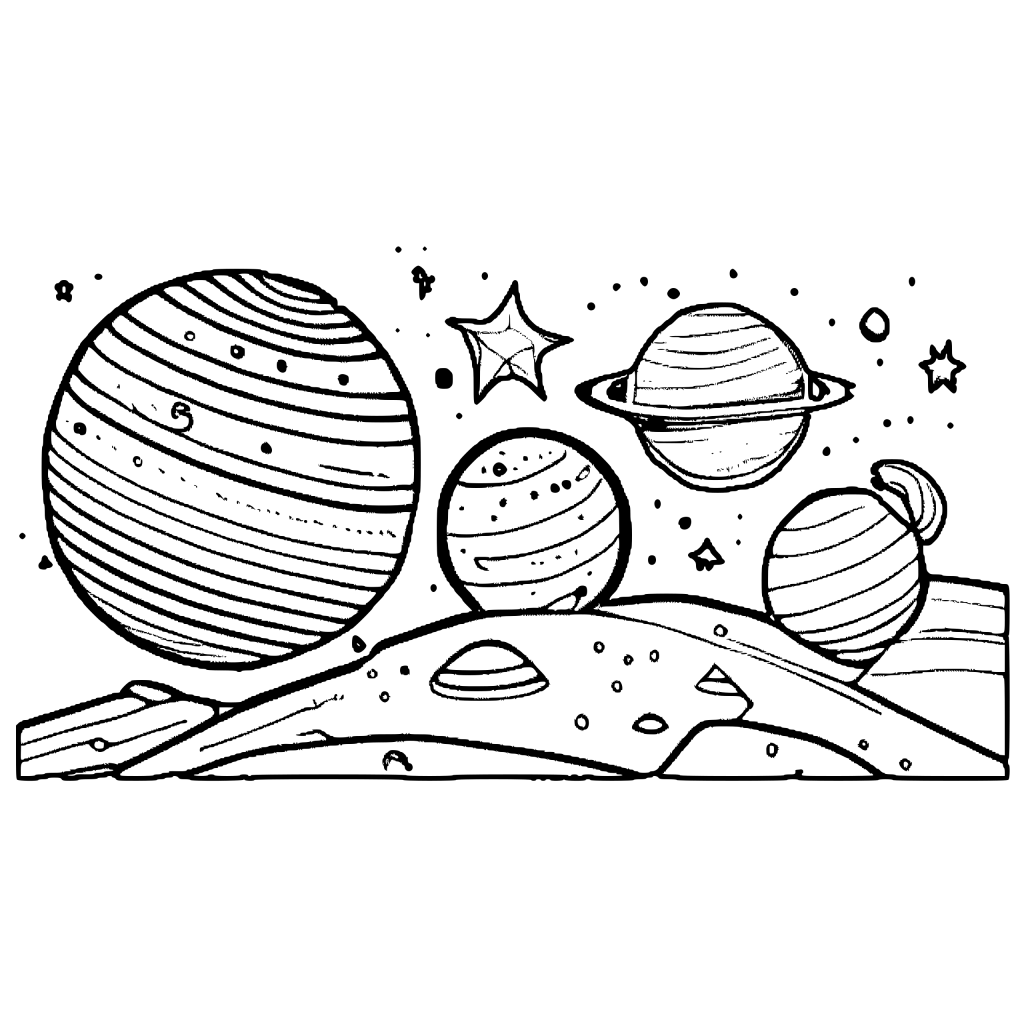Small Worlds with Big Discoveries
© NASA/JPL-Caltech
A dwarf planet is a celestial body with planetary mass that orbits the Sun directly. While it is substantial enough to be rounded by its own gravity, it lacks the gravitational dominance required to clear its orbit like the eight classical planets of the Solar System. Pluto, often considered the prototype of a dwarf planet, was classified as a planet for many years until the concept of “dwarf” planets was officially recognized in 2006.
The International Astronomical Union (IAU) established specific criteria for classifying celestial bodies as dwarf planets. Firstly, a dwarf planet must orbit the Sun, placing it within our Solar System. Secondly, it must possess sufficient mass to achieve a rounded shape due to its own gravity, distinguishing it from irregularly shaped bodies like asteroids. However, unlike planets, dwarf planets lack the gravitational strength to clear their orbital vicinity of other sizable celestial objects, except for their satellites such as moons.
Pluto’s reclassification from a planet to a dwarf planet stemmed from its failure to dominate gravitationally in its orbital neighbourhood. Nonetheless, Pluto holds the distinction of being the first recognized dwarf planet. Presently, five celestial bodies in our Solar System meet the criteria for classification as dwarf planets: Pluto, Eris, Ceres, Makemake, Gonggong, Quaoar and Haumea.
In June 2008, the International Astronomical Union (IAU) introduced a fresh classification called “plutoids” within the dwarf planet category. Plutoids refer to dwarf planets situated beyond Neptune in their orbit around the Sun. All dwarf planets except Ceres fall into the category of plutoids. Due to its location within the asteroid belt, Ceres does not meet the criteria to be classified as a plutoid.
CHARACTERISTICS

- Size and Mass: Dwarf planets vary in size, with diameters ranging from a few hundred to a few thousand kilometers. They are significantly smaller than the traditional planets like Earth, Mars, and Jupiter. While they possess enough mass to be rounded by their own gravity, they are not massive enough to have cleared their orbits of debris, which is a criterion for full planetary status.
- Orbital Dynamics: Dwarf planets orbit the Sun like planets, but their orbits can be more eccentric and inclined. They may have elongated or irregular orbits that take them into regions far from the Sun, such as the Kuiper Belt or the scattered disk.
- Composition: Dwarf planets are composed of various materials, including rock, metal, and ice. Their compositions can vary widely depending on factors like their distance from the Sun and their formation history. Surface features may include craters, mountains, valleys, and plains, providing clues about their geological history and past activity.
- Moons and Satellites: Many dwarf planets have natural satellites or moons orbiting around them. These moons can vary in size, shape, and composition. The presence of moons around dwarf planets can provide valuable information about their formation and evolution, as well as insights into their gravitational interactions.
- Location: Dwarf planets are predominantly found in the outer regions of the solar system, beyond the orbit of Neptune. They may inhabit regions such as the Kuiper Belt, which contains a vast population of icy bodies, or the scattered disk, which consists of objects with highly eccentric orbits.
- Classification: Dwarf planets are officially recognized as a distinct category of celestial bodies by the International Astronomical Union (IAU). Their classification is based on specific criteria, including their size, shape, and orbital characteristics, which distinguish them from both planets and asteroids.
- Plutoids: Plutoids are a subgroup of dwarf planets that orbit the Sun beyond Neptune. The term “plutoid” was coined by the IAU in 2008 and includes dwarf planets such as Pluto, Eris, Makemake, and Haumea.
CRITERIA

The concept of dwarf planets emerged from a divergence between dynamical and geophysical perspectives on what constitutes a planet. Dynamically, the solar system is categorized into bodies that gravitationally dominate their surroundings (ranging from Mercury to Neptune) and those that do not, like asteroids and Kuiper belt objects.
A celestial body may exhibit dynamic (planetary) geology when it possesses enough mass for its mantle to become plastic under its own gravity, resulting in a rounded shape. However, achieving this rounded shape requires significantly less mass than clearing the surrounding space near its orbit. Consequently, there exists a population of objects that are sizable enough to display planet-like features and geology, yet lack the mass to clear their orbital neighborhood.
Notable examples include Ceres, located in the asteroid belt, and Pluto, situated in the Kuiper belt. These bodies exemplify the dynamic interplay between gravitational forces and geophysical processes, leading to their classification as dwarf planets.
The definition of a dwarf planet by the IAU outlines three essential criteria that a celestial body must satisfy to receive this classification:
PLANETARY ORBIT
A fundamental criterion for a celestial body to be classified as a dwarf planet is that it must orbit the Sun directly. This means that the dwarf planet follows a path around the Sun, similar to the orbits of planets within our solar system.
It should have its own independent orbital paths around the Sun. Unlike moons or satellites, which orbit planets, dwarf planets maintain their orbits directly around the Sun.
Dwarf planets may have eccentric (non-circular) and inclined orbits. But, despite their eccentricities and inclinations, dwarf planets maintain stable orbits around the Sun over extended periods. While their paths may intersect with those of other celestial bodies, they do not typically exhibit erratic or chaotic orbital behaviour.
HYDROSTATIC EQUILIBRIUM
Dwarf planets must possess sufficient mass for their self-gravity to surpass rigid body forces, prompting them to adopt a nearly spherical shape, indicative of hydrostatic equilibrium. This equilibrium arises from the delicate balance between inward gravitational force and outward pressure generated by the body’s internal structure.
As such, the internal pressure within a dwarf planet is robust enough to counteract its weight, maintaining its shape. This pressure results from the gravitational compression of the planet’s materials, with denser substances concentrated towards the core and lighter materials towards the surface. Consequently, dwarf planets exhibiting hydrostatic equilibrium often exhibit geological phenomena like tectonic activity, volcanic eruptions, and surface erosion, all propelled by the internal forces stemming from gravitational compression and heat. The attainment of hydrostatic equilibrium typically involves planetary differentiation, wherein denser materials migrate towards the core while lighter substances ascend towards the surface, contributing to the formation of distinct layers within the dwarf planet and defining its internal structure.
UNCLEARED ORBIT
Dwarf planets, defined partly by their inability to clear their orbital neighbourhood of debris, exist within dynamic environments influenced by gravitational interactions and orbital dynamics. These celestial bodies, though possessing sufficient mass to form a nearly spherical shape, lack the gravitational dominance required to clear their orbits of significant debris.
Consequently, objects such as asteroids or other dwarf planets often share their orbital paths, perpetuating a crowded orbital environment. This dynamic nature is especially pronounced in regions like the Kuiper Belt or scattered disk, where many dwarf planets reside among vast populations of icy bodies and debris. Within these regions, complex gravitational interactions give rise to orbital resonances, collisions, and the formation of clusters of objects with similar paths. Even the presence of moons or natural satellites orbiting dwarf planets fails to contribute significantly to clearing their orbits; instead, these satellites coexist within the same orbital vicinity, adding to the diversity of objects within the dwarf planet’s system without altering the fundamental criterion for classification.
DWARF PLANETS

| NAME | MEAN DISTANCE FROM SUN (AU) | ORBITAL PERIOD (years) | DIAMETER (km) | MEAN ORBITAL SPEED (km/s) | MASS (×1021 kg) | DENSITY (g/cm3) | MOONS | YEAR OF DISCOVERY |
| CERES | 2.77 | 4.61 | 939.4 ± 0.2 | 17.90 | 0.93835 ± 0.00001 | 2.16 | 0 | 1801 |
| ORCUS | 39.22 | 245.62 | 910+50-40 | 4.75 | 0.55 ± 0.01 | 1.4 ± 0.2 | 1 | 2004 |
| PLUTO | 39.5 | 247.69 | 2377 ± 3 | 4.74 | 13.03 ± 0.03 | 1.85 | 5 | 1930 |
| SALACIA | 42.33 | 275.47 | 846 ± 21 | 4.57 | 0.49 ± 0.01 | 1.50 ± 0.12 | 1 | 2004 |
| HAUMEA | 43.19 | 283.84 | ≈ 1560 | 4.53 | 4.01 ± 0.4 | ≈ 2.02 | 2 | 2003 |
| QUAOAR | 43.61 | 287.97 | 1086 ± 4 | 4.51 | 1.2 ± 0.05 | 1.7 ± 0.1 | 1 | 2002 |
| MAKEMAKE | 45.58 | 306.17 | 1430+38-22 | 4.41 | ≈ 3.1 | 1.9 ± 0.2 | 1 | 2005 |
| GONGGONG | 67.5 | 550.31 | 1230 ± 50 | 3.63 | 1.74 ± 0.07 | 1.74 ± 0.16 | 1 | 2007 |
| ERIS | 67.84 | 558.77 | 2326 ± 12 | 3.62 | 16.47 ± 0.09 | 2.43 ± 0.05 | 1 | 2003 |
| SEDNA | 488.98 | 10812.82 | 906+314-258 | ≈ 1.3 | ≈ 1.7 | ≈ 2.25 | 0 | 2003 |
CERES
Dwarf planet Ceres, located in the asteroid belt between Mars and Jupiter, is the closest dwarf planet to the Sun and the only one in the inner solar system. It has a diameter of approximately 950km, making it the smallest of the recognized dwarf planets. Discovered in 1801 by Giuseppe Piazzi, Ceres was initially classified as an asteroid before being reclassified as a dwarf planet in 2006.
Ceres is of significant interest due to its abundance of ice, water, and minerals, making it a potential destination for human colonization. It has a rocky core with an icy mantle, possibly containing a substantial amount of water. Ceres is also known for its mysterious white spots and the presence of water vapour plumes.
ORCUS
Orcus is a trans-Neptunian plutino dwarf planet located in the Kuiper belt, sharing similarities with Pluto. It has a large moon named Vanth and is often referred to as the “anti-Pluto” due to its orbital resonance with Neptune in the opposite phase from Pluto. Although not officially recognized as a dwarf planet by the IAU, Orcus meets all the requirements for this classification.
Discovered in 2004, Orcus has a diameter estimated between 870 to 960 km and a mass of about 6.4e+20 kg. It has a long orbital period of 245 years and is in a 2:3 orbital resonance with Neptune. Orcus is known for its composition, with a rocky core and an icy mantle containing water and methane ice.
PLUTO
Learn more about Pluto here.
Pluto, once considered the ninth planet in our solar system, is now classified as the largest known dwarf planet. Located in the Kuiper Belt beyond Neptune, Pluto is a complex world with mountains, valleys, plains, craters, and glaciers.
Discovered in 1930 by Clyde Tombaugh, Pluto was reclassified as a dwarf planet in 2006 due to not meeting the criteria set by the International Astronomical Union for a planet. It has a thin atmosphere composed mainly of nitrogen, methane, and carbon monoxide. With a diameter of about 1,400 miles, Pluto is orbited by five moons, the largest being Charon, which is about half the size of Pluto. The New Horizons spacecraft provided detailed images of Pluto during its flyby in 2015, revealing its unique surface features and icy composition.
SALACIA
Salacia is a dwarf planet located in the Kuiper Belt, beyond the orbit of Neptune. While not officially recognized as a dwarf planet by the IAU, it is considered almost certainly a dwarf planet due to its characteristics. Salacia is named after the wife of Neptune in Roman mythology and is notable for its extremely low albedo, reflecting less sunlight than other objects in the outer solar system. It has a rocky core surrounded by a thick mantle of ice and possesses one known moon named Actaea.
Salacia’s dark surface is unusual among large trans-Neptunian objects, and it is one of the largest trans-Neptunian objects, ranking between seventh and twelfth in size among similar objects. Its orbit extends beyond Neptune, with a rotational period of about 6.1 hours and an orbital period of approximately 274 years. Salacia’s diameter is estimated to be between 373.727 to 835.680 kilometers, making it one of the largest objects in the Kuiper Belt.
HAUMEA
Haumea is a dwarf planet located in the Kuiper Belt, beyond Neptune’s orbit. Discovered in 2004, it is named after the Hawaiian goddess of childbirth. Haumea is an elongated object with dimensions of about 2,322 × 1,704 × 1,138 km, making it one of the fastest-rotating large objects in the solar system with a rotation period of 3.92 hours. It has a thin water ice crust covering a rocky interior and is one of the densest Kuiper Belt objects. Haumea has two moons, Namaka and Hi’iaka, and in 2017, astronomers discovered a ring around it, making it the most distant solar system body with a ring. The dwarf planet’s rapid spin distorts its shape, giving it an oval appearance, resembling a football.
Haumea’s surface features include the Dark Red Spot, possibly an impact crater revealing its interior. Its moons, named after daughters of Haumea, have orbital periods and masses relative to Haumea. Haumea’s unique characteristics and history, including a giant collision in the past, contribute to its fascinating nature in the outer solar system.
QUAOAR
Quaoar is a dwarf planet located in the Kuiper Belt, about 4 billion miles away from the Sun. Discovered in 2002, Quaoar is approximately 690 miles wide, making it the seventh-largest trans-Neptunian object. It orbits the Sun every 286 years and has a small moon named Weywot.
Recent observations using ground-based telescopes and the European Space Agency’s Cheops satellite revealed that Quaoar possesses a dense ring system, a unique feature for a dwarf planet. The presence of this ring, located at a distance beyond what is conventionally expected, has puzzled scientists, as rings are typically expected to exist within a celestial body’s Roche limit. The discovery of Quaoar’s ring challenges traditional understanding and theories about planetary ring systems, prompting further research to understand how these rings are maintained and why they have not coalesced into moons as expected.
MAKEMAKE
Makemake is a dwarf planet located in the outer solar system, beyond the orbit of Neptune. Discovered in 2005, it is the second brightest object in the Kuiper Belt, slightly dimmer than Pluto. Makemake is about two-thirds the size of Pluto, with a diameter of approximately 870 miles (1,400 kilometers). It has a reddish-brown colour and is composed of rock and ice, with an average temperature of around -243°C.
Makemake orbits the Sun every 310 Earth-years, ranging from about 38 to 53 astronomical units from the Sun. It has a moon named S/2015 (136472) 1, nicknamed MK 2, which is about 100 miles (160 km) in diameter. Makemake played a significant role in the reclassification of Pluto from a planet to a dwarf planet by the International Astronomical Union in 2006.
GONGGONG
Gonggong, also known as minor-planet designation 225088 Gonggong, is a dwarf planet located in the scattered disc beyond Neptune. Discovered in July 2007, Gonggong has a highly eccentric and inclined orbit, ranging from 34 to 101 astronomical units from the Sun. It is the sixth-farthest known Solar System object, with a distance from the Sun of 88 AU as of 2019. Gonggong is in a 3:10 orbital resonance with Neptune, completing three orbits around the Sun for every ten orbits of Neptune. With a diameter of approximately 1,230 km, Gonggong is comparable in size to Pluto’s moon Charon, making it the fifth-largest known trans-Neptunian object.
The dwarf planet’s large mass suggests it may be plastic under its own gravity, qualifying it as a dwarf planet. Gonggong’s surface is red, likely due to the presence of organic compounds called tholins, and it also contains water ice. Named after the Chinese water god responsible for chaos and floods, Gonggong’s unique characteristics, including a slow rotation period and a natural satellite named Xiangliu, make it a fascinating object in the outer solar system.
ERIS
Eris is a dwarf planet located in the scattered disk beyond Neptune, making it the most massive and second-largest known dwarf planet in the Solar System. Discovered in 2005, Eris has a diameter of 2,326 km (1,445 miles), slightly smaller than Pluto. It has a highly eccentric orbit and is the ninth-most massive object orbiting the Sun. Eris has a moon named Dysnomia, about one-eighth its size, with an orbital period of about two weeks. This dwarf planet’s surface is coated with white methane ice, and it is one of the most reflective bodies in the solar system.
Eris is located about 96.3 AU from the Sun, more than three times the distance of Neptune or Pluto. Its extreme distance and small size make it challenging to observe without powerful telescopes. Eris played a significant role in the reclassification of Pluto from a planet to a dwarf planet by the International Astronomical Union in 2006.
SEDNA
Sedna is a dwarf planet located in the outer solar system, discovered in 2003. It is named after the Inuit goddess of the sea and is believed to be the first object discovered from the Oort Cloud. Sedna has a highly elliptical orbit, ranging from 76 to 1,007 times the Earth-Sun distance, with a period of about 12,599 years. Its diameter is estimated to be between 915 and 1,600 km, making it one of the largest trans-Neptunian objects. Sedna’s reddish colour, distinct from typical icy objects, raised questions about its composition and origin.
Astronomers debate its classification, with many considering it a dwarf planet due to its size and shape. Sedna’s orbit provides unique opportunities for studying interstellar radiation and the solar wind. Despite its distance, Sedna’s discovery has contributed to redefining our understanding of the outer solar system and planetary classifications.
